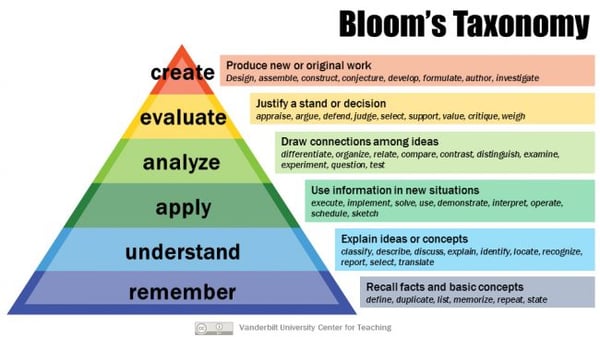
For over fifty years, teachers have used Bloom's Taxonomy in classrooms to guide learning, structure lessons, and assess student performance. However, times change and the taxonomy levels are no exception. In fact, the framework has been revised to reflect current educational practices and 21st-century innovation.
So, how can today's teachers navigate the levels using digital technology like video learning?
This article explores the different levels of Bloom's Taxonomy, why this framework is invaluable to educators, and how video learning can help achieve each level for any age group, from kindergarten to higher education.
Let’s jump in.
Navigating the six levels of Bloom's Taxonomy
To understand Bloom's Taxonomy, let's start from the beginning, well, five decades ago. In 1956, educational psychologist Benjamin Bloom and colleagues wrote the book Taxonomy of Educational Objectives. It became the definitive source of learning outcomes for educators, and its methods became widely referred to as Bloom's Taxonomy.
Its smart design helped educators categorize cognitive skills in a hierarchy, ranging from basic knowledge recall to evaluation. The framework also included three domains: psychomotor, affective, and cognitive — with the cognitive domain taking center stage.
Envisioned as a pyramid, Bloom's old framework categorizes learning objectives into six levels, from lowest to highest:
- Knowledge
- Comprehension
- Application
- Analysis
- Synthesis
- Evaluation
Ultimately, each level builds upon the preceding one, indicating progress in cognitive capabilities. In 2001, the six taxonomy levels received a major upgrade to include verb-driven categories and expanded knowledge dimensions.

Today's version of Bloom's Taxonomy.
You could call it: Bloom's Taxonomy 2.0.
Bloom's Taxonomy verbs
The taxonomy evolved in the hands of cognitive psychologists and curriculum theorists, the most notable were the duo Lorin Anderson and David Krathwohl. The revised version emerged as a more dynamic vision of cognitive processes, where fixed levels of learning were reshaped into active, verb-driven categories.
The revised taxonomy framework offers a holistic view of student learning in the cognitive domain. Below is the modified version, ranked from lowest to highest, and a few Bloom's Taxonomy verb examples linked to each level of thinking.
- Remembering - recalling and recognizing information
- Verbs: describe, find, list
- Understanding - summarizing and interpreting information and concepts
- Verbs: compare, define, explain
- Applying - implementing information in new situations
- Verbs: classify, examine, show
- Analyzing - distinguishing different parts of a whole
- Verbs: categorize, compare, identify
- Evaluating - creating assessments based on criteria
- Verbs: debate, determine, verify
- Creating - producing something new and original
- Verbs: predict, design, improve
As part of the revision, the taxonomy was expanded to include four knowledge dimensions:
- Factual: the basic details or elements a student must know about a subject or discipline
- Conceptual: the student learns interrelationships among the elements within a larger context
- Procedural: the student learns how to do something and different methods of inquiry
- Metacognitive: awareness of how learning works in relation to one's self
So, how can educators use this framework for deeper learning? Read on to discover why Bloom's Taxonomy verbs and knowledge dimensions are essential in today's classrooms.
Why Bloom's Taxonomy matters
.webp?width=600&height=298&name=Image%201%20(5).webp)
Why Bloom's Taxonomy matters
Bloom's Taxonomy is a beneficial framework for educators when creating lesson plans and designing courses. However, how an educator uses this method will differ greatly depending on learning styles and grade levels.
For example, a kindergarten teacher may use Bloom's Taxonomy verbs such as "find" or "name" linked to the level "remembering" to learn colors or shapes. Whereas a middle school teacher may use Bloom-style questions to prompt deeper thinking connections, such as:
- "What is the underlying theme of the story?" (analyzing)
- "What would happen if?" (creating)
In higher education, instructors use Bloom's Taxonomy to push students to move beyond remembering and recalling information and deeper into analysis and creation. For example, instructors may use taxonomy verbs and higher-order thinking in class discussions or to provide an extra challenge for learners who are ready to go further. Or they may use it to design an advanced course. An example may look like:
Upon completion of this course, students will be able to:
- "Demonstrate proficiency in ..."
- "Identify the key components of ..."
So why is Bloom's Taxonomy so essential? It's a living framework that continues to evolve — that's its beauty. Educators can use this to their advantage, especially with e-learning, and integrate technology that encourages higher-order thinking skills.
How? Enter video.
Video learning: The catalyst for next-level instruction
At its core, video learning involves creating and utilizing video content as a primary way to deliver educational material. This method includes various formats, from recorded lectures to interactive video modules.
So, how does video enhance instruction and learning experiences? Simply put, this technology makes learning more interactive, accessible, and engaging — it's truly multisensory. With this in mind, video learning is an ideal tool for designing educational experiences that align with Bloom's Taxonomy.
How video learning aligns with each level of Bloom's Taxonomy
.webp?width=600&height=400&name=Image%202%20(3).webp)
Remembering
Through video, educators can help students with the most basic learning skill of Bloom's Taxonomy: remembering. From K-12 to higher education, educators can use instructional videos (or create their own) to engage learners in multiple ways, such as creating interactive video lessons. Studies show that using video in these ways (and others) increases cognitive processing. In turn, this helps students absorb, retain, and recall information effectively.
Video learning also allows for self-paced learning, letting students access content when ready. This strategy is great for synchronous, asynchronous, and hybrid learning environments.
Pro tip: Record an instructional video that students can watch before class (or refer back to when they need a refresher). This is an effective way to introduce the flipped classroom model to your curriculum.
Other tips to consider when creating videos:
- limit videos to about five minutes or less unless you're delivering a ton of new content.
- balance auditory and visual elements throughout the video.
- break videos into short segments by topic or theme.
Understanding
Learning videos also increase understanding, another key level in Bloom's Taxonomy. Today's students have an attention span of between 8 and 12 seconds, which is challenging to work with. Creating explainer videos can help break down complex subjects more effectively than text. Even more, research suggests explainer videos have "strong learning effects" within educational contexts. Why? They are visually appealing, driven by storytelling, and easier to process than lectures alone.
In addition, the visual effects or animation used in explainer videos can capture and retain learners' attention much longer than text alone. This action enables students to better interpret, explain, and understand information and concepts at any grade level.
Pro tip: Embrace micro-learning. Instead of putting together a 30-minute explainer video about a topic, create smaller ones. These bite-sized videos help students understand one learning objective at a time, allowing for better processing and memory recall.
Applying
Once students retain and understand the content, it's time for them to apply what they've learned. When students work towards this taxonomy level, they engage in active learning. Educational experts suggest students learn more when participating in active learning strategies.
.webp?width=600&height=400&name=Image%203%20(5).webp)
Creating videos is an active learning technique that can help students apply what they learn in fresh and creative ways. For example, educators can introduce their students to the art of screencasting. Screencast videos are digital screen recordings often paired with audio to explain or demonstrate a topic or idea. Students can use this technique to craft videos that showcase their understanding of concepts.
Pro tip: Educational platforms like WeVideo and their standards-aligned Assignment Ideas Library can help generate lessons (for any grade) that reinforce Bloom's Taxonomy at the application level. For example, one video assignment idea, Screencast Your Thinking, has students record their screens and narrate audio to visualize their thinking as they solve a problem.
Analyzing
At this stage of Bloom's Taxonomy, students need opportunities to ask questions, think critically, and propose different solutions. Using video can help students practice this level of analysis. For example, having learners create a video to reflect on a topic or concept can help them execute Bloom's Taxonomy verbs, such as categorize, compare, or identify.
For a science project, middle school teachers can have students work in groups to create a video comparing and contrasting eukaryotic and prokaryotic cells. Instructors can ask college students to design a video identifying and explaining an author's point of view or argument.
Pro tip: Have students work in groups to create a video mapping out possible solutions to a problem. For example, have the students create a video that:
- defines a problem
- evaluates the pros and cons of potential solutions
- includes graphics, charts, or multimedia tools summarizing their findings and solutions
Evaluating
Once students can think critically about a concept, can they take a stand or justify their decision regarding this topic? Bloom's Taxonomy evaluation level has students address these questions. At this point, they create assessments, judgments, or opinions based on learned criteria. And video learning aligns with these advanced objectives.
For example, educators can ask students to find video evidence to support their views, arguments, or ideas. This strategy can be used at any grade level. By finding a video clip that provides a fact or critical point, students go beyond applying knowledge to a new concept or topic. After discovering the evidence, they justify why they chose their answer.
Pro tip: Making multimedia projects interactive can also drive deeper understanding and real-time learning. Using interactive video features like multiple-choice questions, polls, creative free response, discussion boards, branched learning, and other tools can help students support their views, foster critical thinking skills, evaluate their learning, and collaborate with peers.
These interactive elements also deliver instant feedback to students while they work, helping educators identify learner gaps and inform future instruction.
Creating
Challenging students to produce their own video content can satisfy the highest level of Bloom's Taxonomy - creating. This form of video learning unlocks student agency. Rather than just applying what they know about a subject, have learners develop a new video project demonstrating their creativity, innovation, and mastery. Creating storyboards and scripts can add another dimension to the assignment.
For example, have students craft their own commercials to practice persuasive writing. They can choose an existing product or invent a brand-new item. Using editing tools, music, greenscreens, and voiceovers can help students really make the project pop!
Pro tip: WeVideo's standards-aligned Assignment Ideas Library can help generate lessons that spur imagination. For example, in the K-12 assignment Show Off Your Passion, students create a video teaching their classmates how to do something they love. Students can make the video using an external camera, webcam, screen recorder, or stock media with voiceover narration.
Instructors can apply the same idea at an advanced level in college classrooms. For example, they can have students create their own videos for course reviews, labs, case studies, and self-reflection (a video log or Vlog).
Wrapping up
Bloom's Taxonomy ultimately encourages a holistic approach to education, promoting the development of well-rounded learners equipped with a strong foundation in cognitive skills. Educators can use video learning to ignite curiosity, foster creativity, and encourage deeper exploration of subject matter.
Educators are better positioned to support student success and foster a lifelong love of learning by incorporating video learning into lesson planning.
Discover the power of interactive video
.jpg)